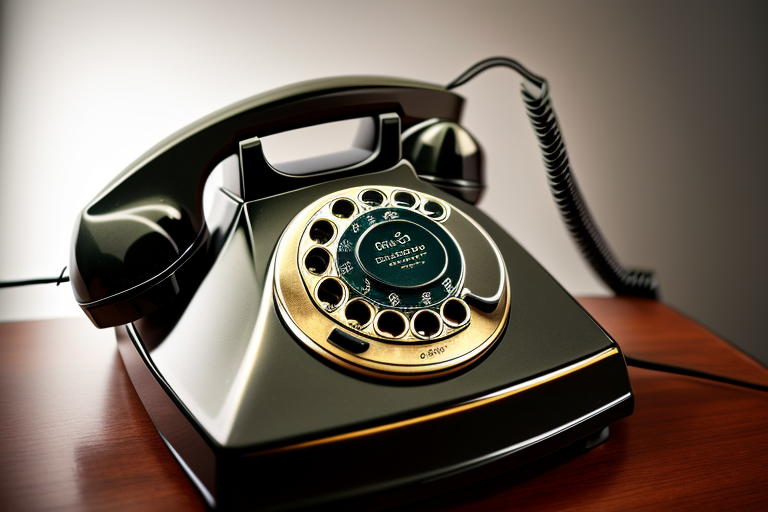The history of the first phone ever made is a fascinating journey that traces back to the 19th century. It all began with the invention of the telephone by Alexander Graham Bell, a Scottish-born scientist and inventor. Bell’s creation revolutionized communication and paved the way for the development of modern telecommunication technology.
The first telephone, which Bell patented in 1876, consisted of a simple device that transmitted sound waves through electrical signals. This breakthrough allowed people to communicate over long distances without the need for physical presence. It was a groundbreaking achievement that forever changed the way we connect with one another.
Over time, the telephone underwent significant advancements and improvements. Early models featured basic designs and limited functionality. However, as technology progressed, rotary dials were introduced, replacing the manual switchboards and enabling more efficient dialing. The transition from analog to digital systems further enhanced the capabilities of telecommunication.
The impact of the telephone on society cannot be overstated. It connected people across vast distances, enabling instant communication and fostering new social interactions. The telephone industry experienced rapid growth, with telecommunication services becoming widely available to the general public. The introduction of cordless and mobile phones, and later smartphones, revolutionized telecommunication even further.
Looking ahead to the future of telecommunication, emerging technologies like 5G networks, virtual reality, and artificial intelligence hold immense potential. These advancements are set to shape the way we communicate and interact in the digital age. Telecommunication has come a long way since the first phone was made, and its evolution continues to surprise and amaze us.
Invention of the Telephone
The invention of the telephone by Alexander Graham Bell marked a significant milestone in the history of communication. Bell’s creation revolutionized the way people connected and interacted with each other, paving the way for the modern telecommunications industry we know today.
Alexander Graham Bell, a Scottish-born scientist and inventor, is credited with inventing the first practical telephone in 1876. His invention was a result of years of experimentation and refinement, building upon the work of earlier inventors and scientists. Bell’s telephone used a simple yet ingenious mechanism that converted sound waves into electrical signals, which could then be transmitted over long distances.
The impact of Bell’s invention was immense. Prior to the telephone, communication over long distances was limited to written letters or telegrams, which were time-consuming and often unreliable. The telephone revolutionized this process by allowing people to speak directly to each other in real-time, regardless of the distance between them. It brought people closer together, enabling instant communication and fostering connections that were previously unimaginable.
Early Telephone Models
The early telephone models mark a significant milestone in the evolution of communication technology. Starting with the first prototype developed by Alexander Graham Bell, these early models paved the way for the future of telephony. The first telephone prototype, created by Bell in 1876, consisted of a simple device with a transmitter and a receiver. It was a breakthrough invention that allowed for the transmission of sound over long distances. However, the early models were far from the sleek and compact designs we are familiar with today.Over time, telephone designs underwent several transformations. The early commercial models featured improvements in functionality and aesthetics. They evolved from bulky and cumbersome devices to more compact and user-friendly models. The introduction of the rotary dial system in the 1890s brought a significant change in the way users interacted with the telephone, replacing the manual switchboard operators.To better understand the evolution of early telephone models, let’s take a closer look at the key milestones in their development:
| Year | Key Milestone |
|---|---|
| 1876 | Creation of the first telephone prototype by Alexander Graham Bell. |
| 1890 | Introduction of the rotary dial system, simplifying the process of dialing phone numbers. |
| 1927 | Development of the first fully automatic dial telephone, eliminating the need for manual dialing. |
| 1930s | Introduction of the first wall-mounted telephones, offering convenience and space-saving solutions. |
These early telephone models played a crucial role in shaping the future of communication technology. They laid the foundation for the development of more advanced and sophisticated telephony systems that we rely on today. The evolution of telephone designs from the first prototype to the early commercial models represents a remarkable journey of innovation and progress in the field of telecommunications.
Improvements in Telephone Technology
The history of telephone technology is marked by significant advancements that have revolutionized communication. One of the key improvements in telephone technology was the introduction of rotary dials. Prior to rotary dials, telephones relied on manual switchboards and operators to connect calls. The rotary dial allowed users to directly dial a phone number, eliminating the need for operator assistance.
Another major advancement in telephone technology was the transition from analog to digital systems. Analog systems transmitted voice signals as electrical currents, while digital systems converted voice signals into binary code. This shift to digital technology improved call quality, increased capacity, and enabled the integration of additional features such as call waiting and caller ID.
To better understand the improvements in telephone technology, let’s take a closer look at the introduction of rotary dials and the transition from analog to digital systems:
| Advancement | Description |
|---|---|
| Introduction of Rotary Dials | The rotary dial allowed users to directly dial phone numbers, eliminating the need for operator assistance. It revolutionized the way calls were made and increased the speed and efficiency of communication. |
| Transition from Analog to Digital Systems | The shift from analog to digital systems brought about significant improvements in call quality and capacity. Digital systems converted voice signals into binary code, enabling clearer and more reliable communication. Additionally, digital technology paved the way for the integration of advanced features and services. |
These advancements in telephone technology laid the foundation for the modern telecommunications systems we use today. They have transformed the way we communicate, making it faster, more convenient, and more efficient.
The Impact of the Telephone on Society
The invention of the telephone by Alexander Graham Bell had a profound impact on society, transforming the way people communicate and revolutionizing long-distance communication. Before the telephone, people relied on written letters or telegrams to convey messages, which could take days or even weeks to reach their destination. However, with the introduction of the telephone, communication became instant and accessible to anyone with a telephone line.
The telephone connected people across long distances, bridging the gap between loved ones separated by geographical boundaries. It allowed individuals to hear the voices of their family and friends, making communication more personal and intimate. No longer did people have to rely solely on written words to express their thoughts and emotions; they could now hear the tone and inflection in someone’s voice, adding depth and richness to conversations.
Furthermore, the telephone played a significant role in shaping social interactions. It brought people closer together, enabling them to stay connected and maintain relationships regardless of physical proximity. The telephone became a vital tool for businesses, allowing for faster and more efficient communication between colleagues and clients. Social gatherings and events were organized with ease, and the telephone became a central hub for coordinating plans and sharing information.
In summary, the telephone had a transformative impact on society, revolutionizing communication by connecting people across long distances and shaping social interactions. Its introduction marked a significant milestone in the history of communication technology, paving the way for further advancements and innovations in the field.
The Telephone Industry and its Growth
The telephone industry has come a long way since its early days of limited availability. It all started with the invention of the telephone by Alexander Graham Bell in the late 19th century. At first, telephones were only accessible to a privileged few, but as the technology advanced and became more affordable, telecommunication services began to spread rapidly.
In the early years, telephone networks were primarily operated by a single company, with limited coverage and connectivity. However, with the growing demand for communication, more companies entered the market, leading to increased competition and expansion of services. This resulted in the widespread adoption of telecommunication services, making telephones a common household item.
- Initially, telephone lines were mainly used for voice communication, allowing people to connect and have conversations over long distances.
- As technology progressed, additional features were introduced, such as call waiting, caller ID, and voicemail, enhancing the overall user experience.
- The telephone industry also witnessed the transition from analog to digital systems, which improved the quality and reliability of phone calls.
Today, telecommunication services have become an integral part of our daily lives, with landline and mobile phones being used for both personal and business purposes. The telephone industry continues to evolve, with advancements in technology and the introduction of new communication devices like smartphones. The growth of the telephone industry has truly revolutionized the way we communicate, connecting people from all corners of the world.
Telephone Innovations and Modernization
The history of telecommunication is marked by significant innovations and advancements in telephone technology. Over the years, the telephone has undergone a remarkable transformation, leading to the introduction of various groundbreaking devices. One of the most notable innovations in telephone technology was the development of cordless phones. These devices allowed users to make and receive calls without being restricted by cords or wires, providing a new level of convenience and mobility.
Another major milestone in telephone innovation was the advent of mobile phones. With the introduction of mobile phones, communication became truly portable. People could now make calls from almost anywhere, breaking the barriers of distance and revolutionizing the way we connect with each other. The rise of smartphones further revolutionized telephone technology, combining the functionalities of a phone, computer, and multimedia device into a single handheld device. Smartphones have become an integral part of our lives, offering a wide range of features and applications that go beyond traditional telecommunication.
The Future of Telecommunication
The future of telecommunication holds exciting possibilities, with emerging technologies set to transform the way we communicate. One of the most anticipated developments is the advent of 5G networks. With its lightning-fast speeds and low latency, 5G promises to revolutionize the way we connect, enabling seamless communication and powering innovative applications.
5G networks will not only enhance traditional voice and data services but also pave the way for the Internet of Things (IoT) to flourish. With billions of devices expected to be connected, from smart homes to autonomous vehicles, 5G will provide the necessary infrastructure to support these interconnected systems. This will open up a world of opportunities for automation, real-time data analysis, and improved efficiency across various industries.
In addition to 5G, other emerging technologies are poised to shape the future of telecommunication. Virtual reality (VR) and augmented reality (AR) have the potential to revolutionize how we communicate and interact with each other. Imagine attending a virtual meeting or experiencing a live concert from the comfort of your own home.
Artificial intelligence (AI) also holds immense promise in telecommunication. AI-powered chatbots and virtual assistants are already transforming customer service, providing personalized and efficient support. As AI continues to advance, it will further enhance communication systems, enabling natural language processing and predictive analytics.
The future of telecommunication is undoubtedly exciting, with 5G networks and emerging technologies set to redefine how we connect and communicate. As these technologies continue to evolve, we can expect a world where communication is faster, more immersive, and seamlessly integrated into our daily lives.
Telecommunication in the Digital Age
Telecommunication has undergone a significant transformation in the digital age, thanks to the integration of internet-based communication platforms and services. With the rise of the internet, traditional telephone systems have given way to more advanced and versatile methods of communication.
One of the key developments in telecommunication in the digital age is the emergence of Voice over Internet Protocol (VoIP) technology. This technology allows for voice communication to be transmitted over the internet, enabling users to make phone calls using their internet connection. VoIP has become increasingly popular due to its cost-effectiveness and flexibility.
Additionally, the integration of internet-based communication platforms, such as messaging apps and video conferencing tools, has revolutionized the way we communicate. These platforms provide instant and seamless communication across long distances, allowing individuals and businesses to connect and collaborate effortlessly.
The digital age has also witnessed the widespread adoption of mobile communication devices, such as smartphones and tablets. These devices have become essential tools for communication, offering access to a wide range of communication services, including voice calls, messaging, video calls, and internet browsing.
Furthermore, the digital age has paved the way for the development of advanced telecommunication services, such as cloud-based communication systems. These systems enable businesses to streamline their communication processes and enhance productivity by integrating various communication channels into a unified platform.
In conclusion, telecommunication in the digital age has experienced a remarkable evolution with the integration of internet-based communication platforms and services. This transformation has brought about greater convenience, efficiency, and connectivity in our daily communication, shaping the way we interact and collaborate in both personal and professional settings.
Emerging Technologies in Telecommunication
Emerging Technologies in Telecommunication
The world of telecommunication is constantly evolving, and emerging technologies are playing a significant role in shaping its future. Two key technologies that hold immense potential are virtual reality (VR) and artificial intelligence (AI).
Virtual Reality (VR)
Virtual reality is no longer just a concept from science fiction movies; it is becoming a reality in the field of telecommunication. VR technology allows users to immerse themselves in a simulated environment, providing a sense of presence and interaction. In the context of telecommunication, VR can revolutionize how we communicate and experience the world.
Imagine being able to have virtual meetings with colleagues from different parts of the world, feeling as if you are all in the same room. VR can create a more immersive and engaging communication experience, enhancing collaboration and breaking down geographical barriers.
Artificial Intelligence (AI)
Artificial intelligence is another emerging technology that is transforming telecommunication. AI systems have the ability to analyze vast amounts of data, make predictions, and learn from user interactions. In the telecommunication industry, AI can be used to improve customer service, optimize network performance, and enhance security.
AI-powered chatbots, for example, can provide instant and personalized customer support, reducing the need for human intervention. AI algorithms can also analyze network data in real-time, identifying potential issues and optimizing network performance to ensure seamless communication.
The Future of Telecommunication
As virtual reality and artificial intelligence continue to advance, they hold great promise for the future of telecommunication. These technologies have the potential to revolutionize how we communicate, making it more immersive, efficient, and personalized.
However, it’s important to note that with these advancements come challenges and ethical considerations. Privacy concerns, data security, and the potential impact on human interaction are just a few of the factors that need to be carefully addressed as we embrace these emerging technologies.
In conclusion, virtual reality and artificial intelligence are paving the way for a new era of telecommunication. As these technologies continue to evolve, we can expect exciting innovations and transformative changes in how we connect and communicate.
Frequently Asked Questions
- Q: Who invented the first telephone?
A: The first telephone was invented by Alexander Graham Bell.
- Q: How did the telephone revolutionize communication?
A: The telephone transformed communication by allowing people to talk to each other across long distances, breaking barriers and connecting individuals like never before.
- Q: What were the early telephone models like?
A: Early telephone models were simple and bulky devices with a receiver and a transmitter. They evolved from the first prototype to more commercially viable designs.
- Q: What advancements have been made in telephone technology?
A: Telephone technology has seen numerous advancements, including the introduction of rotary dials, touch-tone keypads, and the transition from analog to digital systems.
- Q: How did the telephone impact society?
A: The telephone revolutionized social interactions by enabling instant communication, connecting people across long distances, and shaping the way we communicate and interact with each other.
- Q: How has the telephone industry grown over the years?
A: The telephone industry has experienced significant growth, from its early days of limited availability to the widespread adoption of telecommunication services, leading to the establishment of global communication networks.
- Q: What are some innovations in telephone technology?
A: Innovations in telephone technology include the introduction of cordless phones, mobile phones, and the rise of smartphones, which have revolutionized the way we communicate and access information.
- Q: What does the future hold for telecommunication?
A: The future of telecommunication looks promising with the potential impact of emerging technologies like 5G networks, which will provide faster and more reliable communication, and other advancements that will further enhance connectivity and convenience.
- Q: How has telecommunication evolved in the digital age?
A: Telecommunication has evolved in the digital age with the integration of internet-based communication platforms and services, enabling instant messaging, video calls, and other forms of online communication.
- Q: What role can emerging technologies play in telecommunication?
A: Emerging technologies like virtual reality and artificial intelligence have the potential to shape the future of telecommunication by enhancing communication experiences, improving network efficiency, and enabling new forms of communication.






